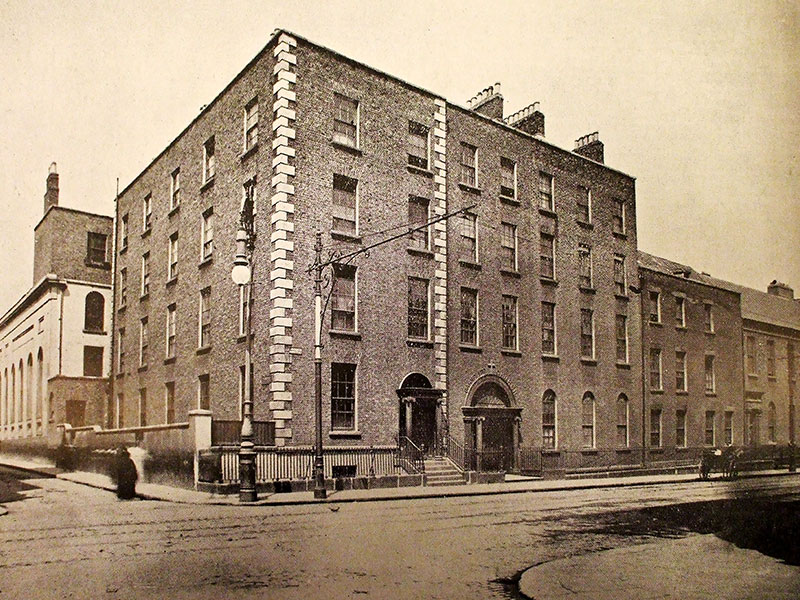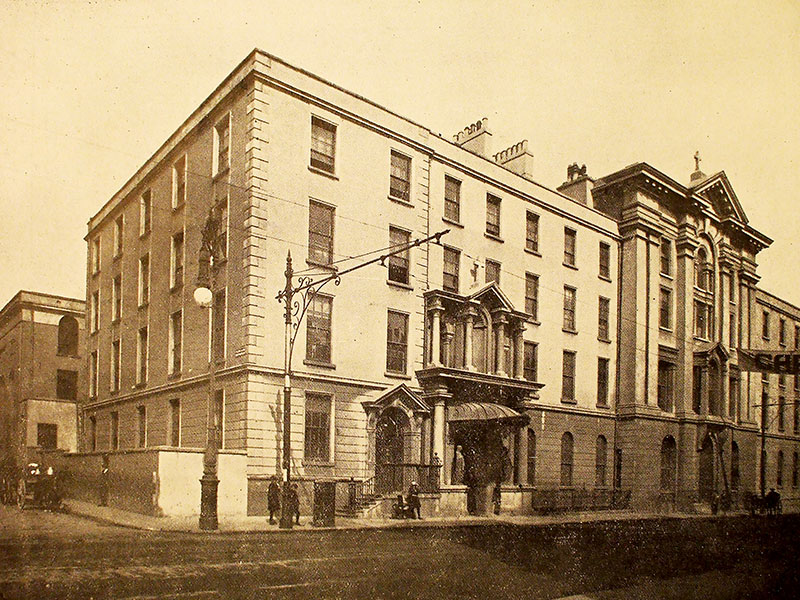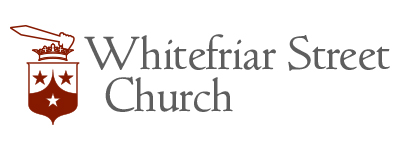History
A brief History of Whitefriar Street Church
…down through the years
The first Carmelites arrived in Ireland in the 1270s, and established a friary at Leighlinbridge in Co. Carlow. In Dublin, Sir Robert Bagot, chief justice of the King’s Bench, built them a house in St Peter’s parish on the south side of the little walled city of Dublin. He had bought this bit of land (on which modern Whitefriars stands) from the Cistercian Abbey of Baltinglass in Co. Wicklow. The priory thrived but dark times were to come in the form of the Protestant Reformation during the sixteenth century. The suppression of the Irish houses began with places like White Abbey in Kildare town. Whitefriars, Dublin, was surrendered on August 3, 1539.
Early in the seventeenth century, the Carmelites were back in Dublin, and had established themselves in Cook Street. By 1728, the Carmelites had settled themselves in Ashe Street. They remained there, working amongst the Dublin people and in the surrounding districts, until the lease of their house expired and the landlord would not renew it. They then moved to a house in French Street (later called Upper Mercer Street) and built a chapel in Cuffe Lane close by. This was in 1806.
A Dublin youth, John Spratt, had, after being attracted to the Order at its Dublin chapel, gone to Spain and received the Carmelite habit in Cordova. When he returned, he came to the Dublin house, of which he was soon made prior. He set himself, like so many other Catholics at this time, to try to do something for the education of the children of the Catholic poor, and accordingly opened his first school in Longford Street in 1822. This was moved to a more spacious site in Whitefriar Street in 1824.
The Longford Street property had been part of medieval Whitefriars. Fr Spratt managed to acquire more of the old site. The Community moved to Whitefriar Street in 1825 and, a year later, the Archbishop of Dublin laid the foundation stone of the new church. The architect, George Papworth (1781-1855), was also the designer of Dublin’s St Mary’s Pro-Cathedral on Marlborough Street, and of a number of large country houses in Ireland. Although an account of the new building remarked that “the whole expense is about £4,000; and proves how much can be done with small means, when taste and judgment are combined,” the debt was a heavy one for the Irish Carmelites.

The Carmelite Church
The Carmelite church in Whitefriar Street stands on the same site as their pre-Reformation Dublin Priory, though nothing remains of the older buildings. The church – dedicated to Our Lady of Mount Carmel – was consecrated on November 11, 1827.
The church as we see it today is very different to that which was consecrated in 1827. All that is left of that structure is the outer wall on Whitefriar Place with its large bronze lettering just below the roof. By 1840, the building had proved to be too small for the congregation. The second stage of the development of this site took place in 1842, and mainly consisted of using the existing church as the south side of the new church, adding a new nave and north aisle. This extension to the church firmly established it as one of the largest churches in the city on a very limited site, with the main approach from a narrow street that was rapidly dwindling in importance. The church as it is at present is virtually the same as it was in 1844, if we omit St Thérèse’s chapel, and place the high altar at the east end beneath the current gallery.
The next major work
The next major work, the most recent, was undertaken by Rev. C. Haughey, O.Carm., in 1951. The entrances were inadequate and indirect – being concentrated in Whitefriar Street – while the great majority of traffic was coming from the opposite end behind the high altar. The solution was simple and direct, involving minor structural alterations only. The scheme reversed the church completely, placing the high altar at the west end and building on a sacristy. Now direct access was available from the main thoroughfare of Aungier Street. In this entrance hallway was erected a life-size depiction of Calvary – a favoured place to pause and pray for so many visitors to the church. During the progress of this work it was decided to form a new chapel off the north aisle similar to the shrine of St Thérèse in Lisieux. To reproduce it exactly was impossible having regard to the cost, but the same feeling was contrived by adopting a similar shape and a simplified Romanesque style. Four altars are contained in this side chapel, each dedicated to saints of particular significance for us: St Valentine, St Jude, St Anne, and Pope St Pius X, and each saint is represented by a statue in a niche of gold mosaic over their altar.

The Whitefriar Street complex is more than just a working church. Above the entrance to the church and along Aungier Street is the Community building where the friars live in community. Behind the church, our primary school – St Enda’s – still thrives. Between the Community building and the school is the Carmelite Community Centre which was opened by the President of Ireland, Mrs Mary McAleese, in May 1999. Up until 1995, there was a three storey building which served many of the needs of the people of the area. In 1995 this building was destroyed in a fire which took the life of a nun – Sr. T. Roche – who worked in the parish. The new building now serves the needs of the local people and offers facilities which the old building never could. There is a crèche, meeting rooms, counseling rooms, a room for quiet reflection, rooms for art and crafts and a number of multi-purpose rooms.
As Carmelites, our religious life is a choice to share life in Community so that our vocation may be strengthened and our ministry be more effective. Community is not an antidote to loneliness, nor a substitute for family life. It is a commitment to live with people of our own Order in such a way that our options for prayer and for service are evident – and so we pray together, liturgically and otherwise, and we work in co-operation with each other. Our presence in the wider local community is a witness to the love of God and our belief in him. We welcome all those who wish to share this belief and to pray to God or who may seek guidance in any way or wish to join our community.
Text taken from “The Church of Our Lady of Mount Carmel (Whitefriar Street Church): A History & Guide”
For a more in-depth analysis of the architecture of Whitefriar Street Church.
For a more detailed discussion of the history of Whitefriar Street Church.
For a document published in 1927 to celebrate the first centenary of the return of the Carmelites in Whitefriar Street.
Address
The Church of Our Lady of Mount Carmel & Shrine of Saint Valentine
56 Aungier Street, Dublin 2
D02 YF57, Ireland
Call Us
Carmelite Friars & All Enquiries
Phone: 01 475 8821
Email Us
hello@whitefriarstreetchurch.ie
